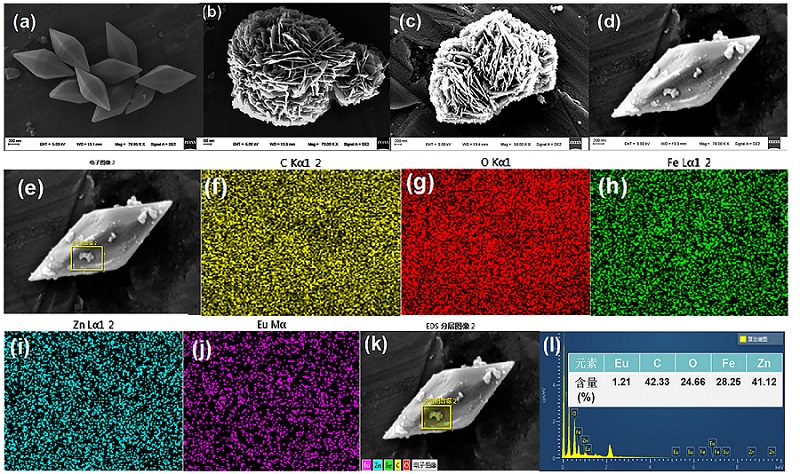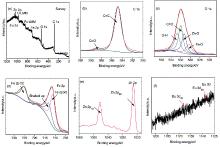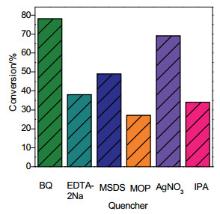化学学报 ›› 2019, Vol. 77 ›› Issue (11): 1184-1193.DOI: 10.6023/A19070268 上一篇 下一篇
研究论文
孟双艳a, 王明明a, 吕柏霖a, 薛群基bc*, 杨志旺a*( )
)
投稿日期:2019-07-18
发布日期:2019-09-26
通讯作者:
薛群基,杨志旺
E-mail:yangzw@nwnu.edu.cn
基金资助:
Meng Shuangyana, Wang Mingminga, Lü Bolina, Xue Qunjibc*, Yang Zhiwanga*( )
)
Received:2019-07-18
Published:2019-09-26
Contact:
Xue Qunji,Yang Zhiwang
E-mail:yangzw@nwnu.edu.cn
文章分享

采用原位合成法将稀土元素Eu掺杂到半导体ZnO中,并与MIL-53(Fe)复合,成功制备了三维(3D)纳米复合光催化剂Eu-ZnO/MIL-53(Fe),通过X射线衍射(XRD)、红外(FT-IR)、扫描电子显微镜(SEM)、紫外可见漫反射光谱(UV-Vis DRS)、光致发光光谱(PL)、X射线光电子能谱分析(XPS)及电化学阻抗谱(EIS)等手段对复合材料的结构、形貌以及光学电学性能进行了详细的表征.实验结果表明:引入稀土元素可以极大地提高MIL-53(Fe)的光催化效率,同时促进光生电子-空穴的有效分离,使得催化活性进一步提高.通过活性捕捉实验和电化学手段对该反应可能的反应机理进行探究,结果表明:该光催化过程是通过空穴(h+)和羟基自由基(·OH)共同作用实现苯甲醇的选择性氧化.通过循环实验和表征参加光反应前后的催化剂的结构来探究该催化剂的光稳定性和热稳定性,结果表明该复合型光催化剂具有良好的光稳定性和热稳定性.
孟双艳, 王明明, 吕柏霖, 薛群基, 杨志旺. Eu掺杂的ZnO/MIL-53(Fe)光催化剂的合成及其对醇类选择性氧化的催化性能研究[J]. 化学学报, 2019, 77(11): 1184-1193.
Meng Shuangyan, Wang Mingming, Lü Bolin, Xue Qunji, Yang Zhiwang. Preparation of Eu-Doped ZnO/MIL-53(Fe) Photocatalyst and Its Catalytic Performance for Selective Oxidation of Alcohols[J]. Acta Chimica Sinica, 2019, 77(11): 1184-1193.




| Entry | Catalyst | Con.b/% | Sel.c/% |
| a Conditions: catalyst (5 mg), benzalcohol (0.2 mmol), CCl4 (6 mL), visible light illumination, 9 h. | |||
| 1 | MIL-53(Fe) | 38 | >99 |
| 2 | ZnO | 5 | >99 |
| 3 | 2% Eu-ZnO | 12 | >99 |
| 4 | 4Eu-ZnO/MIL-53(Fe) | 49 | >97 |
| 5 | 8Eu-ZnO/MIL-53(Fe) | 70 | >97 |
| 6 | 12Eu-ZnO/MIL-53(Fe) | 74 | >97 |
| 7 | 16Eu-ZnO/MIL-53(Fe) | 52 | >97 |
| Entry | Catalyst | Con.b/% | Sel.c/% |
| a Conditions: catalyst (5 mg), benzalcohol (0.2 mmol), CCl4 (6 mL), visible light illumination, 9 h. | |||
| 1 | MIL-53(Fe) | 38 | >99 |
| 2 | ZnO | 5 | >99 |
| 3 | 2% Eu-ZnO | 12 | >99 |
| 4 | 4Eu-ZnO/MIL-53(Fe) | 49 | >97 |
| 5 | 8Eu-ZnO/MIL-53(Fe) | 70 | >97 |
| 6 | 12Eu-ZnO/MIL-53(Fe) | 74 | >97 |
| 7 | 16Eu-ZnO/MIL-53(Fe) | 52 | >97 |
| Entry | Solvent | Con./% | Sel./% |
| a Conditions: 12Eu-ZnO/MIL-53(Fe) (5 mg), benzalcohol (0.2 mmol), visible light illumination, 9 h. | |||
| 1 | Carbon tetrachloride | 72 | >98 |
| 2 | Ethyl acetate | 57 | >98 |
| 3 | Acetonitrile | 23 | >99 |
| 4 | 1, 2-Dichloroethane | 9 | >99 |
| 5 | Absolute ethanol | — | — |
| 6 | N, N-Dimethylformamide | — | — |
| 7 | Anhydrous methanol | — | — |
| Entry | Solvent | Con./% | Sel./% |
| a Conditions: 12Eu-ZnO/MIL-53(Fe) (5 mg), benzalcohol (0.2 mmol), visible light illumination, 9 h. | |||
| 1 | Carbon tetrachloride | 72 | >98 |
| 2 | Ethyl acetate | 57 | >98 |
| 3 | Acetonitrile | 23 | >99 |
| 4 | 1, 2-Dichloroethane | 9 | >99 |
| 5 | Absolute ethanol | — | — |
| 6 | N, N-Dimethylformamide | — | — |
| 7 | Anhydrous methanol | — | — |
| Entry | Substrate | Product | Con.b/% | Sel.b/% |
| a Conditions: substrate (0.2 mmol), 12Eu-ZnO/MIL-53(Fe) (5 mg), CCl4 (6 mL), visible light illumination, 9 h. b Calculated by GC analysis. | ||||
| 1 |  |  | 56 | 81 |
| 2 |  |  | 82 | 98 |
| 3 |  |  | 56 | 94 |
| 4 |  |  | 26 | >99 |
| 5 |  |  | 21 | 90 |
| 6 |  |  | 37 | 92 |
| 7 |  |  | 75 | 96 |
| 8 |  |  | 75 | 100 |
| 9 |  |  | 9 | 90 |
| 10 |  |  | 77 | 100 |
| 11 |  |  | 30 | 100 |
| Entry | Substrate | Product | Con.b/% | Sel.b/% |
| a Conditions: substrate (0.2 mmol), 12Eu-ZnO/MIL-53(Fe) (5 mg), CCl4 (6 mL), visible light illumination, 9 h. b Calculated by GC analysis. | ||||
| 1 |  |  | 56 | 81 |
| 2 |  |  | 82 | 98 |
| 3 |  |  | 56 | 94 |
| 4 |  |  | 26 | >99 |
| 5 |  |  | 21 | 90 |
| 6 |  |  | 37 | 92 |
| 7 |  |  | 75 | 96 |
| 8 |  |  | 75 | 100 |
| 9 |  |  | 9 | 90 |
| 10 |  |  | 77 | 100 |
| 11 |  |  | 30 | 100 |


| [1] |
James B. Chem. Soc. Rev. 2009, 38, 185
doi: 10.1039/B802262N |
| [2] |
Wasielewski M. R. Chem. Rev. 1992, 92, 435
doi: 10.1021/cr00011a005 |
| [3] |
Bard A. J.; Fox M. A. Acc. Chem. Res. 1995, 28, 141
doi: 10.1021/ar00051a007 |
| [4] |
Ravelli D.; Dondi D.; Fagnoni M.; Albini A. Chem. Soc. Rev. 2009, 38, 1999
doi: 10.1039/b714786b |
| [5] |
Gust D.; Moore T. A.; Moore A. L. Acc. Chem. Res. 2009, 42, 1890
doi: 10.1021/ar900209b |
| [6] |
Berardi S.; Drouet S.; Francas L.; Gimbert-Surinach C.; Guttentag M.; Richmond C.; Stoll T.; Llobet A. Chem. Soc. Rev. 2014, 43, 7501
doi: 10.1039/C3CS60405E |
| [7] |
Zeng L.; Guo X. Y.; He C.; Duan C. Y. ACS Catal. 2016, 6, 7935
doi: 10.1021/acscatal.6b02228 |
| [8] |
Yaghi O. M.; Li G. M.; Li H. M. Nature 1995, 378, 703
doi: 10.1038/378703a0 |
| [9] |
Moulton B.; Zaworotko M. J. Chem. Rev. 2001, 101, 1629
doi: 10.1021/cr9900432 |
| [10] |
Férey G.; Mellot-Draznieks C.; Serre C.; Millange F. Acc. Chem. Res. 2005, 38, 217
doi: 10.1021/ar040163i |
| [11] |
Hill R. J.; Long D. L.; Champness N. R.; Hubberstey P.; Schr der M. Acc. Chem. Res. 2005, 38, 335
doi: 10.1021/ar040174b |
| [12] |
Proch S.; Herrmannsd rfer J.; Kempe R.; Kern C.; Jess A.; Seyfarth L.; Senker J. Chem.-Eur. J. 2008, 14, 8204
doi: 10.1002/chem.200801043 |
| [13] |
López-Maya E.; Montoro C.; Colombo V.; Barea E.; Navarro J. A. R. Adv. Funct. Mater. 2014, 24, 6130
doi: 10.1002/adfm.201400795 |
| [14] |
Meng S. Y.; Yang H. J.; Zhu N.; Yang J.; Yang R. R.; Yang Z. W. Acta Chim. Sinica 2019, 77, 461
doi: 10.6023/A18120503 |
|
孟 双艳; 杨 红菊; 朱 楠; 杨 娇; 杨 瑞瑞; 杨 志旺 化学学报 2019, 77, 461
doi: 10.6023/A18120503 |
|
| [15] |
Liu R. X.; He X. Y.; Niu L. T.; Lü B. L.; Yu F.; Zhang Z.; Yang Z. W. Acta Chim. Sinica 2019, 77, 653
doi: 10.6023/A19040113 |
|
刘 茹雪; 何 小燕; 牛 力同; 吕 柏霖; 余 菲; 张 哲; 杨 志旺 化学学报 2019, 77, 653
doi: 10.6023/A19040113 |
|
| [16] | Zhao M.; Ou S.; Wu C. D. Acc. Chem. Res. 2014, 45, 1199 |
| [17] |
Wu P. Y.; Wang J.; Li Y. M.; He C.; Xie Z.; Duan C. Y. Adv. Funct. Mater. 2011, 21, 2788
doi: 10.1002/adfm.201100115 |
| [18] |
Ma, Y. L.; Liu, R. X.; Meng, S. Y.; Niu, L. T.; Yang, Z. W. Acta. Chim. Sinica 2019, 77, 153.
doi: 10.6023/A18090372 |
|
马亚丽, 刘茹雪, 孟双艳, 牛力同, 杨志旺, 雷自强, 化学学报, 2019, 77, 153.
doi: 10.6023/A18090372 |
|
| [19] |
Horcajada P.; Gref R.; Baati T.; Allan P.; Maurin G.; Couvreur P.; Ferey G.; Morris R.; Serre C. Chem. Rev. 2012, 112, 1232
doi: 10.1021/cr200256v |
| [20] |
Sun D. R.; Li Z. H. Chin. J. Chem. 2017, 35, 135
doi: 10.1002/cjoc.201600647 |
| [21] |
Shen L. J.; Liang R. W.; Wu L. Chin. J. Catal. 2015, 36, 2071
doi: 10.1016/S1872-2067(15)60984-6 |
| [22] |
Zhang W. Q.; Li Q. Y.; Yang X. Y.; Ma Z.; Wang H. H.; Wang X. J. Acta Chim. Sinica 2017, 75, 80
doi: 10.3866/PKU.WHXB201607293 |
|
张 文强; 李 秋艳; 杨 馨雨; 马 征; 王 欢欢; 王 晓军 化学学报 2017, 75, 80
doi: 10.3866/PKU.WHXB201607293 |
|
| [23] |
Liang R. W.; Shen L. J.; Jing F. F.; Qin N.; Wu L. ACS Appl. Mater. Interfaces 2015, 7, 9507
doi: 10.1021/acsami.5b00682 |
| [24] |
Liang R. W.; Chen R.; Jing F. F.; Qin N.; Wu L. Dalton Trans. 2015, 44, 18227
doi: 10.1039/C5DT02986D |
| [25] |
Liang R. W.; Huang R.; Ying S. M.; Wang X. X.; Yan G. Y.; Wu L. Nano Res. 2017, 11, 1109
doi: 10.1007/s12274-017-1730-0 |
| [26] |
Liang R.; Jing F. F.; Shen L. J.; Qin N.; Wu L. Nano Res. 2015, 8, 3237
doi: 10.1007/s12274-015-0824-9 |
| [27] |
Jing F. F.; Liang R. W.; Xiong J. H.; Chen R.; Zhang S. Y.; Li Y. H.; Wu L. Appl. Catal. B:Environ. 2017, 206, 9
doi: 10.1016/j.apcatb.2016.12.070 |
| [28] |
Liang R. W.; Jing F. F.; Yan G. Y.; Wu L. Appl. Catal. B:Environ. 2017, 218, 452
doi: 10.1016/j.apcatb.2017.06.075 |
| [29] |
Liang R. W.; Shen L. J.; Jing F. F.; Wu W. M.; Qin N.; Lin R.; Wu L. Appl. Catal. B:Environ. 2015, 162, 245
doi: 10.1016/j.apcatb.2014.06.049 |
| [30] |
Araya T.; Jia M.; Yang J.; Zhao P.; Cai K.; Ma W. H.; Huang Y. P. Appl. Catal. B:Environ. 2017, 203, 768
doi: 10.1016/j.apcatb.2016.10.072 |
| [31] |
Liu Q. X.; Zeng C. M.; Ai L. H.; Hao Z.; Jiang J. Appl. Catal. B:Environ. 2018, 224, 38
doi: 10.1016/j.apcatb.2017.10.029 |
| [32] |
Huang W. Y.; Liu N.; Zhang X. G.; Wu M. H.; Tang L. Appl. Surf. Sci. 2017, 425, 107
doi: 10.1016/j.apsusc.2017.07.050 |
| [33] |
Yang Z. W.; Xu X. Q.; Liang X. X.; Lei C.; Wei Y. L.; He P. Q.; Lv B. L.; Ma H. C.; Lei Z. Q. Appl. Catal. B:Environ. 2016, 198, 112
doi: 10.1016/j.apcatb.2016.05.041 |
| [34] | Ernández-Carrilloa, M. A.; Torres-Ricárdeza, H. R.; García-Mendozaa, M. F.; Ramírez-Moralesa, E.; Rojas-Blancoa, L.; Díaz-Floresa, L. L.; Sepúlveda-Palaciosb, G. E.; Paraguay-Delgadoc, F.; Pérez-Hernándeza, G. Catal. Today 2018, doi: org/10.1016/j.cattod.2018.04.060. |
| [35] |
Meng J. C.; Chen Q.; Lu J. Q.; Liu H. ACS Appl. Mater. Interfaces 2019, 11, 550
doi: 10.1021/acsami.8b14282 |
| [36] | Gao B. J.; Zhou J.; Wang H. L.; Zhang G. P.; He J. H.; Xu Q. F.; Li N. J.; Chen D. Y.; Li H.; Lu J. M. Chin. J. Catal. 2019, 37, 148 |
| [37] |
Lucovsky G.; Phillips J. C. Thin Solid Films 2005, 486, 200
doi: 10.1016/j.tsf.2004.11.224 |
| [38] |
Frindell K. L.; Bartl M. H.; Matthew R.; Bazan G. C.; Popitsch A.; Stucky G. D. J. Solid State Chem. 2003, 172, 81
doi: 10.1016/S0022-4596(02)00126-3 |
| [39] |
Carreno N. V.; Fajardo H. V.; Maciel A. P.; Valentini A.; Pontes F. M.; Probst L. F. D.; Leite E. R.; Longo E. J. Mol. Catal. A:Chem. 2004, 207, 91
doi: 10.1016/S1381-1169(03)00496-5 |
| [40] |
Wang D. K.; Huang R. K.; Liu W. J.; Sun D. R.; Li Z. H. ACS Catal. 2014, 4, 4254
doi: 10.1021/cs501169t |
| [41] |
Sin J. C.; Lam S. M.; Lee K. T.; Mohamed A. R. Ceram. Int. 2014, 40, 5431
doi: 10.1016/j.ceramint.2013.10.128 |
| [42] |
Gao Y. W.; Li S. M.; Li Y. X.; Yao L. Y.; Zhang H. Appl. Catal. B:Environ. 2017, 202, 165
doi: 10.1016/j.apcatb.2016.09.005 |
| [43] |
Jian X.; Liu X.; Yang H. M.; Li J. G.; Song X. L.; Dai H. Y.; Liang Z. H. Appl. Surf. Sci. 2016, 370, 514
doi: 10.1016/j.apsusc.2016.02.119 |
| [44] |
Huang X.; Tan C. L.; Yin Z. Y.; Zhang H. Adv. Mater. 2014, 26, 2185
doi: 10.1002/adma.201304964 |
| [45] |
Yu J. G.; Yu X. X. Environ. Sci. Technol. 2008, 42, 4902
doi: 10.1021/es800036n |
| [46] |
Zhang C. H.; Ai L. H.; Jiang J. Ind. Eng. Chem. Res. 2015, 54, 153
doi: 10.1021/ie504111y |
| [47] |
Liang R. W.; Jing F. F.; Shen L. J.; Qin N.; Wu L. J. Hazard. Mater. 2015, 287, 364
doi: 10.1016/j.jhazmat.2015.01.048 |
| [48] |
Khataee A. R.; Karimi A.; Darvishi R.; Soltani C.; Safarpour M.; Hanifehpour Y.; Joo S. W. Appl. Catal. A:Gen. 2014, 488, 160
doi: 10.1016/j.apcata.2014.09.039 |
| [49] |
Zhao F.; Sun H. L.; Gao S.; Su G. Mater. Chem. 2005, 15, 4209
doi: 10.1039/b507584j |
| [50] |
Xu X. Q.; Liu R. X.; Cui Y.; Liang X.; Lei C.; Meng S. Y.; Ma Y. L.; Lei Z. Q.; Yang Z. W. Appl. Catal. B:Environ. 2017, 210, 484
doi: 10.1016/j.apcatb.2017.04.021 |
| [51] |
Sun L. P.; Niu S. Y.; Jin J.; Yang G.; Ye L. Inorg. Chem. Commun. 2006, 9, 679
doi: 10.1016/j.inoche.2006.03.027 |
| [52] |
Jin X.; Ye L.; Wang H.; Su Y.; Xie H.; Zhong Z.; Zhang H. Appl. Catal. B:Environ. 2015, 165, 668
doi: 10.1016/j.apcatb.2014.10.075 |
| [1] | 李飞, 丁汇丽, 李超忠. 基于氟仿衍生的三氟甲基硼络合物参与的烯烃氢三氟甲基化反应[J]. 化学学报, 2023, 81(6): 577-581. |
| [2] | 徐袁利, 潘辉, 杨义, 左智伟. 连续流条件下蒽-铈协同催化的苄位碳氢键选择性氧化反应★[J]. 化学学报, 2023, 81(5): 435-440. |
| [3] | 杨民, 叶柏柏, 陈健强, 吴劼. 可见光催化烷基磺酰自由基启动芳酰肼的烷基磺酰化反应[J]. 化学学报, 2022, 80(1): 11-15. |
| [4] | 马智烨, 叶丽, 吴雨桓, 赵彤. B,N-SnO2/TiO2光催化剂的制备及其光催化性能研究[J]. 化学学报, 2021, 79(9): 1173-1179. |
| [5] | 董奎, 刘强, 吴骊珠. 放氢交叉偶联反应[J]. 化学学报, 2020, 78(4): 299-310. |
| [6] | 张振, 龚莉, 周晓渝, 颜思顺, 李静, 余达刚. 二氧化碳参与的自由基型烯烃双官能团化反应[J]. 化学学报, 2019, 77(9): 783-793. |
| [7] | 戴建玲, 雷文龙, 刘强. 可见光驱使铜盐催化芳香烃二氟烷基化反应[J]. 化学学报, 2019, 77(9): 911-915. |
| [8] | 陈奕霖, 常亮, 左智伟. 可见光催化诱导的Smiles重排研究进展[J]. 化学学报, 2019, 77(9): 794-802. |
| [9] | 杨俊航, 傅晓波, 卢增辉, 朱钢国. 可见光催化烯烃砜基化启动的远程醛基碳-氢键直接硫化反应[J]. 化学学报, 2019, 77(9): 901-905. |
| [10] | 刘茹雪, 何小燕, 牛力同, 吕柏霖, 余菲, 张哲, 杨志旺. 具有分级纳米结构的In2S3/CdIn2S4在可见光下催化苯甲胺的氧化偶联反应[J]. 化学学报, 2019, 77(7): 653-660. |
| [11] | 孟双艳, 杨红菊, 朱楠, 杨娇, 杨瑞瑞, 杨志旺. BiOCl-ov/坡缕石复合可见光催化剂的制备及其对醇类的选择性氧化研究[J]. 化学学报, 2019, 77(5): 461-468. |
| [12] | 马亚丽, 刘茹雪, 孟双艳, 牛力同, 杨志旺, 雷自强. 以UiO-66为前驱体的Fe-ZrO2的制备及其可见光降解性能研究[J]. 化学学报, 2019, 77(2): 153-159. |
| [13] | 余晓叶, 周帆, 陈加荣, 肖文精. 可见光促进的酰胺氮自由基参与的分子内氢胺化反应[J]. 化学学报, 2017, 75(1): 86-91. |
| [14] | 邵天举, 江智勇. 可见光催化有氧脱氢合成2,3-二氢-4-吡啶酮与4-喹诺酮[J]. 化学学报, 2017, 75(1): 70-73. |
| [15] | 裴朋昆, 张凡, 易红, 雷爱文. 可见光促进的苄位Csp3-H键活化官能团化反应[J]. 化学学报, 2017, 75(1): 15-21. |
| 阅读次数 | ||||||
|
全文 |
|
|||||
|
摘要 |
|
|||||